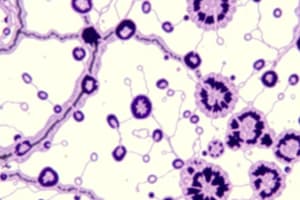Podcast
Questions and Answers
What is the primary function of epithelial tissue?
What is the primary function of epithelial tissue?
- Covers body surfaces and lines cavities (correct)
- Supports and binds other tissues
- Transmits signals
- Responsible for movement
Which type of connective tissue is characterized by fat storage?
Which type of connective tissue is characterized by fat storage?
- Dense connective tissue
- Adipose tissue (correct)
- Blood
- Loose connective tissue
Which histological technique involves creating a solid block around tissue?
Which histological technique involves creating a solid block around tissue?
- Staining
- Fixation
- Embedding (correct)
- Sectioning
What is the primary advantage of electron microscopy over light microscopy?
What is the primary advantage of electron microscopy over light microscopy?
Which of the following best describes histopathology?
Which of the following best describes histopathology?
What does immunohistochemistry mainly utilize to detect specific proteins in tissues?
What does immunohistochemistry mainly utilize to detect specific proteins in tissues?
Which type of muscle tissue is involuntary and striated?
Which type of muscle tissue is involuntary and striated?
Which characteristic is true of artifacts in histology?
Which characteristic is true of artifacts in histology?
What type of epithelial tissue consists of multiple layers of cells?
What type of epithelial tissue consists of multiple layers of cells?
Which application of histology is focused on evaluating the effects of therapeutic interventions?
Which application of histology is focused on evaluating the effects of therapeutic interventions?
Flashcards are hidden until you start studying
Study Notes
Overview of Histology
- Histology is the study of tissues at the microscopic level.
- It involves examining the structure, function, and chemistry of cells and tissues.
- Fundamental to understanding anatomy, physiology, and pathology.
Types of Tissues
-
Epithelial Tissue
- Covers body surfaces and lines cavities.
- Functions: protection, absorption, secretion, sensation.
- Types: simple (one layer), stratified (multiple layers), squamous (flat), cuboidal (cube-shaped), columnar (tall).
-
Connective Tissue
- Supports, binds, and protects other tissues and organs.
- Types: loose (areolar), dense (tendons and ligaments), adipose (fat storage), blood, bone, cartilage.
-
Muscle Tissue
- Responsible for movement.
- Types: skeletal (voluntary, striated), cardiac (involuntary, striated, found in heart), smooth (involuntary, non-striated, found in organs).
-
Nervous Tissue
- Composed of neurons (nerve cells) and glial cells.
- Functions: signal transmission, processing, and supporting.
Histological Techniques
- Fixation: Preserves tissue structure (e.g., formalin).
- Embedding: Infiltrating tissue with a medium (e.g., paraffin) to create a solid block.
- Sectioning: Slicing the embedded tissue into thin sections using a microtome.
- Staining: Enhances contrast of cellular components (e.g., Hematoxylin and Eosin stain).
Light Microscopy
- Most common tool in histology.
- Uses visible light to magnify and visualize tissue architecture.
- Can detect cellular morphology, arrangement, and some intracellular structures.
Electron Microscopy
- High-resolution imaging using electrons.
- Types: Transmission Electron Microscopy (TEM), Scanning Electron Microscopy (SEM).
- Excellent for visualizing ultrastructural details.
Applications of Histology
- Medical diagnosis (pathological examination of tissues).
- Research in developmental biology, cancer biology, immunology.
- Evaluation of responses to therapies and drug effects.
Key Concepts
- Artifacts: Distortions resulting from processing; important to recognize.
- Histopathology: Study of disease at the tissue level.
- Immunohistochemistry: Uses antibodies to detect specific proteins in tissues.
Importance of Histology
- Essential for understanding disease mechanisms.
- Aids in the development of new therapeutic approaches.
- Provides foundational knowledge for medical and biological sciences.
Histology: The Study of Tissues
- Examines tissues at the microscopic level
- Focuses on structure, function, and chemistry of cells and tissues
- Fundamental for understanding anatomy, physiology, and pathology
Types of Tissues
-
Epithelial Tissue: Covers body surfaces and lines cavities
- Functions: protection, absorption, secretion, sensation
- Types:
- Simple: One layer of cells
- Stratified: Multiple layers of cells
- Squamous: Flat cells
- Cuboidal: Cube-shaped cells
- Columnar: Tall, column-shaped cells
-
Connective Tissue: Supports, binds, and protects other tissues and organs
- Types:
- Loose (areolar): Found throughout the body, providing support and flexibility
- Dense: Found in tendons (connect muscle to bone) and ligaments (connect bone to bone)
- Adipose: Stores fat for energy and insulation
- Blood: Transports oxygen, nutrients, and waste products
- Bone: Provides structural support and protection
- Cartilage: Provides cushioning and support, found in joints and ears
- Types:
-
Muscle Tissue: Responsible for movement
- Types:
- Skeletal: Voluntary, striated, attached to bones for movement
- Cardiac: Involuntary, striated, found only in the heart, responsible for pumping blood
- Smooth: Involuntary, non-striated, found in the walls of internal organs, responsible for contractions
- Types:
-
Nervous Tissue: Composed of neurons (nerve cells) and glial cells
- Functions:
- Signal transmission: Carrying messages throughout the nervous system
- Processing: Integrating and interpreting sensory information
- Supporting: Providing structural support and protection for neurons
- Functions:
Histological Techniques
-
Fixation: Preserves tissue structure to prevent decomposition
- Uses chemicals like formalin to crosslink proteins and preserve tissue integrity
-
Embedding: Infiltrating tissue with a medium like paraffin to create a solid block for sectioning
- Paraffin allows for thin sections to be cut without damaging tissue
-
Sectioning: Slicing the embedded tissue into thin sections using a microtome
- Microtome is a specialized instrument that produces precise and thin slices of tissue
-
Staining: Enhances contrast of cellular components for visualization
- Hematoxylin and Eosin (H&E) stain is commonly used:
- Hematoxylin stains nuclei blue
- Eosin stains cytoplasm pink
- Hematoxylin and Eosin (H&E) stain is commonly used:
Microscopy
-
Light Microscopy: Most common microscopy technique in histology
- Uses visible light to magnify and visualize tissue architecture
- Allows observation of:
- Cellular morphology (shape and structure)
- Arrangement of cells
- Some intracellular structures
-
Electron Microscopy: Uses electrons for high-resolution imaging
- Types:
- Transmission Electron Microscopy (TEM): Provides detailed images of internal structures
- Scanning Electron Microscopy (SEM): Provides detailed three-dimensional images of surfaces
- Types:
Applications of Histology
-
Medical Diagnosis: Histopathological examination of tissues helps diagnose diseases
- Biopsies are taken to examine tissues for abnormal cells or structures
- Helps identify and classify different diseases
-
Research
- Developmental biology: Study of tissue formation and development
- Cancer biology: Study of tumor growth and metastasis
- Immunology: Study of the immune system
-
Evaluation of responses to therapies and drug effects
- Histological analysis can monitor treatment effectiveness and identify potential side effects
Key Concepts
- Artifacts: Distortions in tissue samples due to processing
- Recognizable artefacts are important to avoid misinterpretations
- Histopathology: Study of diseases at the tissue level
- Bridges microscopy and clinical pathology
- Immunohistochemistry: Uses antibodies to detect specific proteins in tissues
- Important tool for mapping protein expression and characterizing cell types
Importance of Histology
- Essential for understanding disease mechanisms: Helps identify the cellular and molecular changes associated with diseases
- Aids in the development of new therapeutic approaches: Provides insights into disease processes and potential targets for drug development
- Provides foundational knowledge for medical and biological sciences: Fundamental for understanding the structure and function of the human body at a microscopic level
Studying That Suits You
Use AI to generate personalized quizzes and flashcards to suit your learning preferences.





